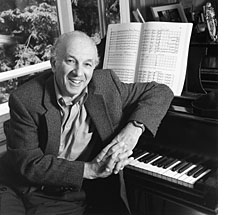
Fall
2000
![]()
Luminaries
Seven
notables contemplate the state of humanities, arts, and social sciences
at MIT and beyond.
![]()
![]()
Soundings is a publication of the School of Humanities, Arts, and Social Sciences at MIT
Comments and questions to shass-www@mit.edu
Living the link: music and science at MIT
 Photo: Graham G. Ramsay |
David Epstein is Professor of Music Emeritus and Senior Fellow in the Arts and Humanities. He joined the MIT Faculty in 1965 and was Music Director and Conductor of the MIT Symphony Orchestra for 33 years, from 1965 to 1998.
This celebration evokes a panoply of recollections, not least among them thoughts about our pioneering forebears who brought this School into existence.The recommendation of the Lewis Committee in 1949 must have been perceived differently at that time from what it would be today, when MIT's programs in the arts and humanities are so extensive and robust. Surely, too, MIT's founding Director of Music, Klaus Liepmann, faced a different cultural picture from what is currently enjoyed at the Institute. Klaus was a builder, a musician armed with an optimist's outlook. His gifts were not only those of musical erudition, but the will to do things—a strength stimulated by the possibilities he envisioned for music at MIT. By his very enthusiasm he communicated the vision to his younger colleagues.
Never did Klaus imagine, however, that the program he initiated would rise to such heights, as he confided to me some years ago as we sat together during the opening ceremonies of Killian Hall. The blossoming of music on this campus was the fulfillment of his life's work.
It has been that for many of us. Few music faculty in those early years anticipated performing ensembles of such brilliance and refinement as we now enjoy, nor the evolution of a generation of student composers and scholars who have moved on to leading graduate programs and into the profession. It has been equally striking to work in the music program with the brilliant science and engineering students whose standards and musical accomplishments are the equal of our music majors, not to mention the new paths in the cyberworld of music emerging from the Media Lab. In a way, we enjoy at MIT what some 100 years ago was a norm in European culture—a diverse, literate and active musical society.
Working in this environment was for me heady stuff. The realization that the musicians in the MIT Symphony Orchestra seemingly had no limit to what they could accomplish was an inspiration to push the repertoire, the programming, the sheer level of the playing as far as it could go. The results were astonishing. They revealed something about performance itself that may be universally applicable—namely, that the limits of attainment are in large degree what performers make of them. The envelope invites being pushed.
It was equally heady to run a seminar on musical structure, as I did every year, in which many players of the MIT Symphony Orchestra participated. We jointly discovered new connections between musical compositions and the implications—indeed, the obligations—for performance that these factors raise. To learn this was not to reinvent the musical wheel, though studies of this sort had a long history in music. For there was a freshness and a brilliance in the insights of my scientist/performer students that was often original and new. Working jointly, we uncovered facts and perspectives about analysis and performance that frequently were innovative, all of which had a marked influence upon my professional life and outlook. As with many of us, my students were my professors. The main difference: they made it through MIT in four years; it took me 33 years.
More power to this artistic vitality at MIT. I wonder what the scene will look like when we celebrate the 100th anniversary of the School of Humanities, Arts, and Social Sciences.
![]()
Copyright © 2000 Massachusetts
Institute of Technology